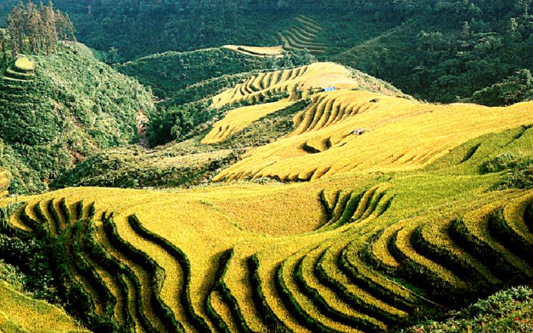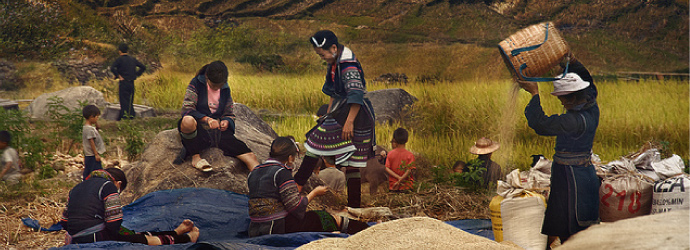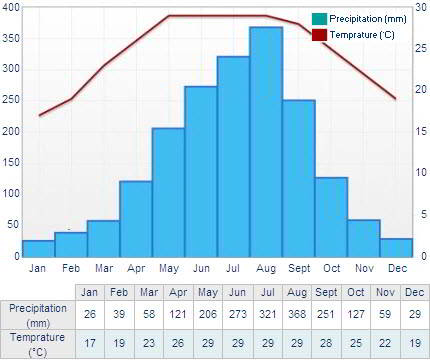Tailor Made Holidays with our travel experts
We'll do our best to call you within 48h

Set high in Vietnam’s northeast mountains, the hamlet of Sapa offers spectacular views of jagged mountain ridges, terraced rice paddies and green valleys inhabited by people of various ethnic minority groups, most of whom congregate in Sapa’s colorful market. Each group has its own distinctive style of dress. From early childhood, girls learn to grow and weave hemp, to dye cloth with indigo, to sew the family’s clothes, and to decorate items with traditional embroidery motifs. More recently, Sapa has become a tourist mecca. Expect hilltribe vendors to follow you and to be persistent in persuading you to buy their handicrafts. If you buy from one vendor and other vendors see you making purchases, they will attempt to sell you their products too. If you’re not interested, just say ‘no’ and ask your guide to walk you away.
Built in the 1920s as a hill station for the French armed forces, Sapa was re-discovered in recent years as a tourist destination. A mountainous area on the Vietnam-China border, Sapa sees 160 days a year of mist and rain, and is home to a wealth of ethnic minorities and hill tribes. Among them are the H'mong, the Dao, and the Montagnards, the “Mountain People,” who cooperated closely with American forces in the Vietnam War. Many French-era colonial buildings remain in the area, lending Sapa a genteel, nostalgic air. Sa Pa is home to some of very colorful hill tribes in the country. The total population of 36,000 consists mostly of minority groups. There are mainly 5 ethnic groups in Sapa district: Hmong, Dzao, Tay, Dzay and a small number of Xa Pho. Approximately 7,000 live in town and the others being scattered in small communes throughout the district.
Most of the ethnic minority people work their land on sloping terraces since the vast majority of the land is mountainous. The unique climate in Sapa has a major influence on the ethnic minorities who live in the area. With sub-tropical summers, temperate winters and 160 days of mist annually, the influence on agricultural yields and health related issues are significant.
The scenery of the Sa Pa region in large part reflects the relationship between the minority people and nature. This is seen especially in the paddy fields carpeting the rolling lower slopes of the Hoang Lien Mountains. The impressive physical landscape which underlies this has resulted from the work of the elements over thousands of years, wearing away the underlying rock. On a clear day, the imposing peak of Fan Si Pan comes into view. The last major peak in the Himalayan chain, Fan Si Pan offers a real challenge to even the keenest walker, the opportunity of staggering views, and a rare glimpse of some of the last remaining primary rain forest in Vietnam.
The Hoang Lien Mountains are home to a rich variety of plants, birds, mammals, amphibians, reptiles and insects, many only found in northwestern Vietnam. For this reason, the Hoang Lien Nature Reserve was made a National Park in 2006.
The climate of Hoang Lien National Park is unique to Vietnam. It is highly seasonal, with a subtropical climate in the summer and a temperate climate during the winter. Annual temperature for Sapa town is 15.4°C, with a maximum of 29.4°C and a minimum of 1°C.
The warmest months are July and August, and the coldest months are December and January. Snow falls in some years on the highest peaks. In summer time, one can feel the climate of four seasons in one day with cool fresh air of spring in the morning, summer weather at noon, clear and cool like autumn in the afternoon and light winter cold at night.
With the combination of great natural landscape, colorful sight and typical culture, Sapa promises to be a wonderful place to visit. Trek down a long the Muong Hoa stream to visit minority villages, enjoy home stay in local house on stilts, join in with locals in the Saturday love market or conquer the top of Fansifan mountain prove a great experience.
Location
Sa Pa District is located in Lao Cai Province, north-west Vietnam, and 350 km north-west of Hanoi, close to the border with China. Sapa is famous both for its fine, rugged scenery and for its rich cultural diversity. French used to consider Sapa as Summer Capital of Northern Vietnam in the early decades of the 20th century. Its naturally gifted beauty keeps attracting more and more people to spend their vacation there since then. Particularly, the place is the foremost choice for honeymoon couples!
Geography & Weather
Geographically, Sapa is exactly a mountainous area of Northwest Vietnam. The whole Sapa District is dominated by the Hoang Lien Son mountain range which is at the Eastern extremity of the Himalayas, being famous with the Vietnam’s highest mountain of Fa si pan at a height of 3,142 m above sea level. The town of Sa Pa lies at an altitude of about 1,600 m, bringing in a cool and foggy site of Sa Pa.
Let’s join a fancy trip to this romantic town!
Taking a night train from Hanoi to Lao Cai, and then 50 minutes more from Lao Cai City by bus, or you can go from Hanoi to Sapa by the new highway with 5h drive. Sapa appears in fanciful fog. Thanks to the height of 1,600 m above the sea level, the average temperature of the area is always 15-18°C, cool in summer, but a bit cold in winter.
Sapa takes its pride in its unique climate in Vietnam. It is highly seasonal, with a subtropical climate in the summer and a temperate climate during the winter. Mean annual temperature for Sa Pa town is 15.4°C, with a maximum of 29.4°C and a minimum of 1°C. The warmest months are July and August, and the coldest months are December and January. Snow falls in some years on the highest peaks. In the morning and afternoon, it is as cool as in spring and autumn. Yet, at noon, it is as sunny and cloudless as in summer. In the evening, it drastically changes into coldness just as in winter. This is actually a unique advantage, making Sapa different from anywhere else in the nation. However, travelers should be noticed that there might be sudden thunderstorm and heavy rains at noon in summer. Yet, subsequently, a rainbow appears turning Sapa into a beautifully magic land with seven colors! So, remember to bring your best camera so as not to miss this magnificent view! April and May are the best time for tourists to watch the most scenic beauties of Sapa, or else it might be cold and foggy before that and rainy after that. During these two peak months, the town is blossoming with pink and white flowers, and green pastures in valleys. The clouds that settle in the valley in early morning would quickly disappear.
Beauty Spots and Resorts
The scenery of the Sapa region in large part reflects the relationship between the ethnic minority people and nature. This is seen especially in the paddy fields carpeting the rolling lower slopes of the Hoang Lien Mountains. The impressive physical landscape, which underlies this, has resulted from the work of the elements over thousands of years, wearing away the underlying rock.
Most tourists agree that it would be regretful if the leisure and relaxation time in cool and fresh weather is not accompanied by visiting trips to Sapa’s prideful natural beauty spots, such as Ham Rong Mountain, Silver Waterfall, Rattan Bridge, Bamboo Forest and Ta Phin Cave. The town is also the starting point for many mountain climbers and scientists who would like to discover the Fansipan Mount, the highest mountain in Vietnam with 3,143 m height. Can you imagine that Hoang Lien Mountain Range is called “the Alps of the North Sea area” since Fansipan Mount also marks its greatest height among others in the Indochina Peninsula as well. The pyramid-shaped mountain is covered with clouds all the year round. On top of the mountain is filled with frequent below zero temperature, especially at high altitudes. On approaching the town, the very first thing tourists may find is the detached wooden mansions and villas perched on top or side of the hills, behind thick pine forests, hided by fog in the morning. Old and new villas with red roofs now appear and then disappear in the green rows of pomu trees, bringing in the beauty of European towns.
Sapa-the land of love
Sapa is home to various families of flowers of captivating colours, unique in the vast country. When Tet, the Lunar New Year Festival, comes, the whole township of Sapa is filled with the pink colour of peach blossom brought from the vast forests of peach just outside the town. Sapa is regarded as the kingdom of orchids. Here, orchid lovers are even amazed by the choice, when trekking in the forest filled with several hundred kinds of orchids of brilliant colours and fantastic shapes, such as Orchid Princess, Orchid of My Fair Lady’s Shoe. Some orchids are named after lovely singing birds such as the canary, salangane’s nest, and more.
Specialties
Foreign tourists are actually fond of scarce and precious specialties of Sapa, such as forest’s product, handicrafts, delicacies (smoked meat, “thang co”, “cai meo”, san lung wine, corn wine, etc.), typical of ethnic minority people. Most travellers do like to bring some of the local fresh vegetables back home for presents. Thanks to the fresh and cool air, Sapa is the ideal land for fresh temperate vegetables such as cabbage, chayote, precious medical herbs, fruit trees (plum, pear), and so on.

Cultural diversity
Sapa is famous for its special cultural diversity in a combination of ethnic minority groups’ culture. Visitors to Sapa will have opportunities to discover the unique customs of the local residents. Local markets are the town’s typically cultural element, which are always crowded and joyful, attracting hundreds of visitors. This is the common place for minority groups to gather and exchange goods. Market sessions are also a chance for local people to promenade. No foreign visitor could help joining such a market session, a typical cultural element of Sapa. What is more, tourists coming to Sapa at weekends have the great chance to learn about local ethnic people’s courtship and martial life, through the Sapa love market and wife kidnapping ceremony of the H’Mong group. The ceremony will begin on April 29th. This is part of a five-day festival, titled Festival on the Cloud, to mark the beginning of the Sapa 2006 tourism year, in the northern mountain township of Sapa, in Lao Cai Province.
Sapa Climate
The climate of Sapa is unique to Vietnam. It is highly seasonal, with a subtropical climate in the summer and a temperate climate during the winter. Annual temperature here is 15.4°C, with a maximum of 29.4°C and a minimum of 1°C. The warmest months are July and August, and the coldest months are December and January. Snow falls in some years on the highest peaks. In summer time, one can feel the climate of four seasons in one day with cool fresh air of spring in the morning, summer weather at noon, clear and cool like autumn in the afternoon and light winter cold at night.

Cat Cat Trek
Trek to Cat Cat, which sits about a mile and a half outside of Sapa. Cat Cat is a sleepy place filled with authentic hill tribes, and is home to a thriving series of cottage industries, selling all the manner of products, including embroidery, sculpture, and art - perfect for souvenirs and mementos.
Matra and Ta Phin Village
Ta Phin Village is five miles from Sapa. Visitors will be able to meet the Red Dao, who are known for their elaborate, special headgear. Visitors can also embark on a 6 to 7 miles (10 to 11 kilometers) circular trek that will pass through both Red Dao and Black Hmong villages.

Heaven’s Gate
Trek near the mountains by Heaven's Gate, for a stunning view overlooking the valley, with its jagged mountains, verdant forests, and elaborate, terraced rice paddies.
Colonial Walking Tour
See the buildings established by the French, which include the town hall, the church and the town square. Don’t forget to stop in at the Sapa Culture Museum as well to learn about local traditions and customs. Afterwards, eat at the Hill Station Restaurant, which features pate, ham, wine and cheese - a legacy of the French. For coffee lovers, there’s a special Italian coffee blend.
Getting here: The best way to get to Sapa is to take a 10-hour overnight train from Hanoi. Departing at night you wake up refreshed the next morning in Sapa ready to begin your adventure. Visiting a more remote hill tribe market requires a 3 to 4.5 hour drive on bumpy dirt roads through mountains. The trip is for the adventurous; otherwise enjoy your time in nearby hill tribe villages.